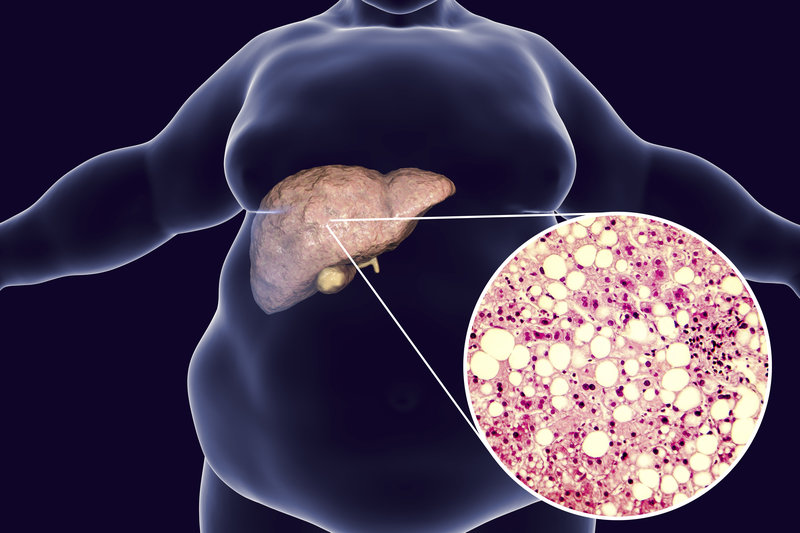Fatty liver disease affects over 30% of population

TEHRAN – Hepatic steatosis or non-alcoholic fatty liver disease (NAFLD), an important non-communicable disease, has affected 30 percent of the population in Iran, member of the research center for gastroenterology and liver diseases at University of Tehran has said.
“Prevalence of NAFLD is higher among female than male,” IRNA quoted Mehdi Saberi Firouzi as saying on Wednesday.
The liver normally contains some fat; an individual is considered to have a fatty liver (hepatic steatosis) if the liver contains more than 5 to 10 percent fat, he said, adding, despite its dangerous side effects, there are no warning signs and symptoms in the early stages.
Although NAFLD is associated with obesity and excessive calorie intake, some 10 to 20 percent of the patients are in normal weight range, he noted, adding that some 30 percent of the people in the country are diagnosed with the disease so far.
The disease can affect children as well as adults, as it is increasingly recognized in children, he regretted.
Criticizing the lack of adequate physical activity among children, he highlighted that “Obesity, overweight and lack of physical activity can cause fatty liver among children.”
He went on to say that unfortunately today, children are at higher risk of developing the disease due to excessive sitting and use of electronic devices such as mobile phones, tablets and TV.
Saberi Firouzi further said drinking eight glasses of water a day, avoiding deep fried food and fast food, reducing the consumption of carbohydrates, including sugars, bread and pasta, increasing vegetables and fruits intake, and taking rich sources of vitamin C, are the most effective ways to prevent and treat fatty liver.
In July, an official with the Ministry of Health Zahra Abdollahi said that obesity has affected 20 percent of the students in the country, as consumption of fast food and carbonated beverages have risen which are the major causes of obesity and overweight.
Moreover, Ali Motlaq, head of cancer department at the Ministry of Health told IRNA that physical inactivity in the country affects about 60 percent of the population, and over 60 percent of the people are suffering obesity.
He also noted that fruit and vegetable consumption among Iranians accounts for a rate of 15 to 20 percent.
Hepatic steatosis or NAFLD
Hepatic steatosis is a buildup of excessive fat in the liver that can lead to liver damage resembling the damage caused by alcohol abuse, but that occurs in people who do not drink heavily. The liver is a part of the digestive system that helps break down food, store energy, and remove waste products, including toxins.
The fat deposits in the liver associated with NAFLD usually cause no symptoms, although they may cause increased levels of liver enzymes that are detected in routine blood tests. Some affected individuals have abdominal pain or fatigue. During a physical examination, the liver may be found to be slightly enlarged.
NAFLD is a very common disorder, occurring in about 25 percent of the global population. Its prevalence is increasing along with the rising prevalence of obesity in industrialized societies, and it is now the most common chronic liver disorder in Western countries, including the United States. NAFLD is more prevalent in individuals of Hispanic, Native American, or Asian than in individuals of European or African.
Between 7 and 30 percent of people with NAFLD develop inflammation of the liver (non-alcoholic steatohepatitis, also known as NASH), leading to liver damage. Minor damage to the liver can be repaired by the body. However, severe or long-term damage can lead to the replacement of normal liver tissue with scar tissue (fibrosis), resulting in irreversible liver disease (cirrhosis) that causes the liver to stop working properly. Signs and symptoms of cirrhosis, which get worse as fibrosis affects more of the liver, include fatigue, weakness, loss of appetite, weight loss, nausea, swelling (edema), and yellowing of the skin and whites of the eyes (jaundice). Scarring in the vein that carries blood into the liver from the other digestive organs (the portal vein) can lead to increased pressure in that blood vessel (portal hypertension), resulting in swollen blood vessels (varices) within the digestive system. Rupture of these varices can cause life-threatening bleeding.
NAFLD and NASH are thought to account for many cases of cirrhosis that have no obvious underlying cause (cryptogenic cirrhosis); at least one-third of people with NASH eventually develop cirrhosis. People with NAFLD, NASH, and cirrhosis are also at increased risk of developing liver cancer (hepatocellular cancer).
NAFLD is most common in middle-aged or older people, although younger people, including children, are also affected. It is often considered as part of a group of conditions known collectively as the metabolic syndrome; in addition to NAFLD, the metabolic syndrome includes obesity, type 2 diabetes or pre-diabetes (insulin resistance), high levels of fats (lipids) such as cholesterol and triglycerides in the blood, and high blood pressure (hypertension). However, a person with NAFLD may not have all or any of the other conditions that make up the metabolic syndrome, and individuals with some or all of those conditions may not have NAFLD.
FB/MQ/MG
Leave a Comment